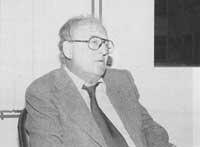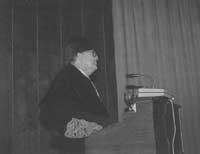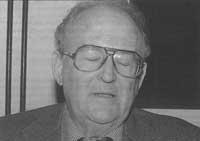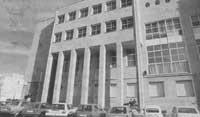Gonzalo Martín Guzman, 40 years immersed in the world of polymers

I met Gonzalo Martín Guzmán in 1975, when, as a young man, I began to study at the School of Chemistry of San Sebastian, born with the intention of graduating in Chemistry. He was dean curator of the faculty and simultaneously professor of General Chemistry.
He was a prominent person, of which he does not generate inference. You can be in your favor or against it. He is a man capable of creating the greatest hatred and the most fervent achicarrado.
To move the Faculty of Chemistry of San Sebastian, a person like her was needed and she has used all the forces to do so. If today the Faculty of Chemistry of San Sebastian is a prosperous and plural reality, it has been the “fault” of this friendly and effective man, and that is why Euskal Herria and Basque culture have a great debt to it.
With the excuse of having been appointed Professor Emeritus, we have approached him to know his life.
Elhuyar: You were born in Madrid in 1924 and studied there. What do you remember from that time?
Gonzalo Martín Guzmán: I finished high school at the Cisneros Institute after the civil war and then began to graduate from the Faculty of Chemistry of the University City. At the same time I was a professor at the Marin Amat academy. There I prepared the entrance to the university and as I had the Special Prize, the director proposed to me to be a professor. At that time the Marin Amat academy was of great prestige. I finished my bachelor's degree in 1946.
E.- What specialties were there at that time?
PS- Then the specialties were classic: organic, analytical and inorganic. There was no biochemistry. We in the bachelor's degree do not study biochemistry. The Faculty of Chemistry of Madrid had great prestige and there were good teachers, but their curriculum was very classic.
I headed for organic chemistry. The professor of organic chemistry then put me to work on a complicated synthesis of heterocyclic compounds. But in summer, working alone in the laboratory, there was a big explosion and I suffered a great shock. I therefore request a change in the subject of research. Then, the plastics section of Patronato Juan de la Cierva was to open and I passed there. I did a thesis on silicones, the first one made in Spain. I finished the thesis in 1950 and became a collaborator of the institute, specifically in the department of Plastics and Rubbers.
E.- He followed Birmingham.

GMG.- Thanks to a scholarship granted by the Board of Trustees Juan de la Cierva I went to England, specifically to the Department of Physical Chemistry of the University of Birmingham. Directed by Sir Harry Melville, it was a world-class laboratory in the field of plastics. It had a huge infrastructure. Besides having many researchers and great teachers, he had an optimal laboratory and service infrastructure. I haven't seen it anywhere else: precision mechanical workshops, medium precision mechanical workshops, electronics, wood and glass workshops. With the help of these workshops, the physical chemistry section of polymers designed and built a light scattering spectrometer. This spectrometer was commercially produced by an English house and used for several years as a standard model in the research of polymeric solutions.
His system was very suitable. Skilled workers and craftsmen did not leave the university because they paid well. Tradition arose. Therefore, generations of workers, electricians and mechanics were created with knowledge of scientific instrumentation, and if you gave them an idea, they could understand and manufacture them.
E.- What is the subject of your thesis in Birmingham?
GMG.- I studied the ramification of macromolecules by radioisotopes. For the first time, kinetic constants were obtained from the transfers of polymerising radical chains. Quantitative values of the speed constants were obtained. The work was very important.
E.- In 1954 he returned to Madrid and went to the patronage Juan de la Cierva. He had problems.
GMG.- I had many problems because the time was right. At that time, the control of the centers of the patronage had little or more people linked to the regime. The source of the problems was my attitude towards research. I wanted to do some research and didn't want another job. However, the goal of the board was to support the industry, but like today, the industry did not know what it wanted and the work was limited to the control and testing sessions. I didn't want that. So I pushed part of the board to go into polymers research. I only in that struggle and from there the problems arose. I always worked alone and never had a budget. I was quite upstairs, but I always had problems.
E.- What was your concrete line of research at that time?
GMG.- We work a lot. We work in polymerization kinetics, especially in vinyl and acrylic monomers. New and very specific techniques were developed to measure the molecular weight of polymers. People believe that molecular weights are of no importance, but the molecular weight of superior polymers is very serious and delicate. In the board we designed an osmometer to measure molecular weights. We also talked about ion polymerization, a very fashionable theme at that time.
E.- Then you went to the USA. What do we tell you about that experience?

GMG.- Through the Fullbright Foundation I was given a visiting professorship. In 1962 I worked in research and teaching at Nôtre-Dame University (Indiana). I studied how to associate carbohydrates with synthetic polymers. In the US it was then a fashion theme. In fact, there was a large amount of agricultural waste and its use was being studied.
Then I went to Philadelphia to Professor Price, invited by him. Price was one of the pioneers in the world of polymers in the US. I worked with a group of macromolecular biochemists in Philadelphia, who needed the vision of a macromolecular chemist to deal with the problems they had. Laboratories were studies of cancer generated in animals. We investigated what happened in carcinogenic nucleic acids. When I returned to Spain in 1964, I wanted to continue on that, but it was impossible because of the working conditions at the Institute of Plastics.
E.- I came from America and returned to the Institute of Plastic and Rubber, the former Board of Trustees Juan de la Cierva, but soon went to Barcelona professor of thermodynamics...
GMG.- Coming from the USA I continued working in Madrid as before. At the end of 1967 I felt very uncomfortable. He had been in high school for twenty years and kept fighting. The director of the institute retired and was replaced by a friend of his. I saw that he had no immigrant and that the situation could get worse. Then there appeared professor oppositions for the Engineering Schools. I presented it and got square.
When I went to Barcelona, no research was done in engineering schools. Therefore, my idea was to teach at school and study in the Barcelona branch of the institute. They did not leave me and I had a very bad time, I mean economically serious. And it is that then the professors of the engineering schools had no exclusive dedication (because most had other work outside of school in some study) and my salary was very low. Less bad that I changed the law and got exclusive dedication.
I was at Terrassa school with a fixed idea. Engineers are not normally researchers, they are professionals, and my goal was to demonstrate that engineers can also conduct basic and abundant research. During the years I did in Terrassa and in the engineering schools of Barcelona, I put many engineers on the path of research. It was then that the first real doctors, those of the thesis, began and not the doctors who had until then obtained professional prestige. It has not been easy task to change the mentality of engineers... One year I said the Introductory Conference for the new course in Barcelona and I commented that engineers have to do research and a scandal arose.
E.- Donostia after...

GMG.- Yes, in 1975 the project of the Petrochemical Faculty of San Sebastian arose and I was proposed to be dean commissioner of the new faculty. I loved the idea. On the one hand, my wife Arantxa is from San Sebastian and on the other, my destiny has been to face new challenges. And this was a real challenge. There were no similar powers in the State. We had to start with zero. When I came to San Sebastian, two of the most enthusiastic promoters of the new faculty, Juan María Araluze, president of the Council, and Felipe Lucena, Director General of the University, died. Everything turned out very hard, but finally we got it and seeing the fruit of 14 years later I am very happy.
At that time we depended on the university of Valladolid and we were far away and as we were little they ignored us. The University of the Basque Country was subsequently created on three campuses. I was appointed vice-rector and Martín Mateo abandoned him. The time was very turbulent. We had all kinds of problems. We lived in economic misery. Imagine that the university now has a budget of 13 billion and then only 200 million.
E.- Returning to the research and creation of the Faculty of Chemistry of San Sebastian, I think your work was enormous. I believe that to a large extent we owe you to be the most fruitful center from the point of view of the research of the University of the Basque Country in ten years from scratch.
GMG.- I sincerely appreciate what you said. I have put all that I have made the effort and also whenever it has been necessary I have closed my eyes and I have gone forward. I came to study and we did it from day one. In 1979 the first theses were read by doctors Iruin and Zamora. In 1976 Ramón Mestres came as professor of organic chemistry and promoted research. He was then a very young teacher. Mestres and I were the only veterans.
The spirit of medieval universities, the small community of teachers and disciples, was a reality for years. It was perceived in everything we did: in the coherence of the students, in the collaboration, in the joy of the holidays we did. Something very beautiful, even if it is very poor.
E.- I will leave at this point the questions that I thought to ask. Want to add something?
GMG.- Yes, the truth. From the beginning I have seen a very complex evolution; very different institutions, 8 years in engineering schools, 15 faculties, 20 years in a research center. I have also worked in professional administration: I was dean of the Chemical Association of Madrid and president of the National Chemical Association of Madrid. I have known the problem of science from many aspects in the last 40 years.
Progress has been made in recent years, but progress has occurred in November and has not been conducted. Be careful. To do this, politicians must understand what science and technology is. Progress is not based solely on technology. If we do not do a science that can never spread, that science will come from outside and we will also have to buy technologies. Today, the most advanced technology is based on high quality science. Therefore, the university must be considered as an institution that can enter the world of technologies. And for this you have to provide infrastructure and possibilities.

There is no infrastructure or service to conduct research. For example, we can get a sum of money to buy high quality equipment, but there are no specialized personnel to manipulate the equipment. The current technology is complex and you cannot think that the researcher has a deep knowledge of all the tools he needs. I call it maintenance infrastructure and services. Specialized personnel are required. Now I have nothing to learn the handling of the X-ray machine and tomorrow of laser light scattering.
Here we are 14 years old. In the department we have no secretaries, no glass workshops, no mechanics, no electronics... As long as this is not, university researchers will not be able to give everything they have inside.
* – * – *
Gonzalo Martín Guzmán told us more things. We cannot transcribe all here. Martin Guzmán is a difficult, debatable character, with whom we will often not agree, but one of the drivers of the investigation that is now carried out in our country has been the same. These lines serve to thank what this great researcher has done for Euskal Herria.





